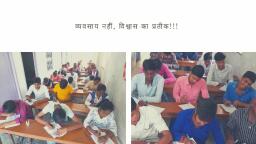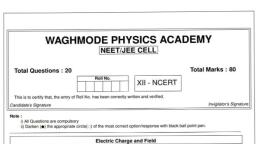Question 1 :
Two electric dipoles of dipole moment $2 \space cm$ and $4 \space cm$ respectively are kept inside a cube of side $'a' \space m$. Total electric flux linked with the cube is (in SI units)
Question 3 :
fast neutrons may most easily be slowed down by which one of the following methods?
Question 4 :
If a body acquires electric charge temporarily under the influence of charged body, then the process is called:
Question 5 :
Ordinary rubber is an insulator. But the specialrubber tyres of aircrafts are made slightlyconducting. Why is this necessary?
Question 7 :
Bulb does not glow when the probs are hanged in air. The reason is:
Question 8 :
Two positive point charges $q_1$ and $q_2$ are kept at the distance d. If the distance between them is triple. Calculate by which factor new electrostatic force is decreased.<br/>
Question 10 :
A gold leaf electroscope is given a positive charge so that its leaves diverge. How is the divergence of leaves affected, when an uncharged rod is brought near its disc ?
Question 11 :
An instrument used in electrostatics to detect thepresence of electric charge on a body is called ..............
Question 13 :
<span class="wysiwyg-font-size-small"><span class="wysiwyg-font-size-small">Another unit for the quantity having the unit $\dfrac{C^2 }{Nm^2}$ is:
Question 14 :
Two equations are given below:<br>A) $\oint \overline {E} .d\overline {A} = \dfrac {Q}{E_{0}}$ B) $\oint \overline {B} . d\overline {A} = 0$
Question 15 :
The electric flux over a sphere of radius $1 m$ is $\phi$. If radius of the sphere were doubled without changing the charge enclosed, electric flux would become
Question 16 :
A charged body is brought near an uncharged gold leaf electroscope. What will be your observation if the body is charged?
Question 18 :
Assertion: Sometime, a crackling sound is heard while taking off sweater during winters.
Reason: This is due to static electric charges.
Question 19 :
Electric field at a distance r from infinitely long conducting sheet is proportional to :
Question 20 :
When a negative charge is taken at a height from earth's surface, then its potential energy:
Question 21 :
The ratio of electric force between two electrons to two protons separated by the same distance in air is:
Question 22 :
State whether true or false:<br/>Alcohol and ether are conducting liquids of electricity. <br/>
Question 23 :
An electron (of charge $-e$) revolves around a long wire with uniform charge density $\lambda$ in a circular path of radius $r$. Its kinetic energy is given by:
Question 24 :
A body is brought near a negatively charged gold leaf electroscope. If the divergence of leaves remains unchanged, state the kind of charge on body in this case.
Question 25 :
You are provided with a negatively charged gold leaf electroscope. State and explain what happens when an ebonite rod rubbed with fur is brought near the disc of electroscope.
Question 26 :
The materials that do not allow flow of electron through them are known as :
Question 27 :
A gold leaf electroscope is given a positive charge so that its leaves diverge. How is the divergence of leaves affected, when a positively charged rod is brought near its disc?
Question 28 :
A charge is placed at the centre of a cube. The electric flux through one face of the cube is :<br/>
Question 29 :
Assertion: Gauss's law show diversion when inverse square law is not obeyed.
Reason: Gauss's law is a consequence of conservation of charges.
Question 31 :
An uncharged insulator can be charged by ______ with another suitable body.<br/><br/>
Question 32 :
State whether true or false.<br/>Metals as compared to non-metals are generally bad conductors of electricity.<br/>
Question 33 :
<p><span class="wysiwyg-font-size-small"><span class="wysiwyg-font-size-small">A body has a total charge of <span class="wysiwyg-font-size-medium"><span class="wysiwyg-font-size-medium">$6.4\times  10^{-19}$<span class="wysiwyg-font-size-small"><span class="wysiwyg-font-size-small">coulomb. It is :</p>
Question 34 :
A particle A has charge +q and a particle B has charge +4q. each having the same m . allowed to fall from rest through the same electric potential difference. the ratio of the speed of A to that of B will e
Question 38 :
In a region of space having a uniform electric field $E$, a hemispherical bowl of radius $r$ is placed. The electric flux $\phi$ through the bowl is
Question 39 :
<span class="wysiwyg-font-size-small"><span class="wysiwyg-font-size-small"><p class="wysiwyg-text-align-left">A charge of $5 C$ is placed at the centre of a spherical gaussian surface of radius $5 cm$. The electric flux through the surface is $\dfrac{1}{\varepsilon _{0}}$ times of</p>
Question 41 :
What is the angle between the electric dipole moment and the electric field due to it on the axial line?
Question 42 :
Some materials have electrons that are tightly bound to the nucleus and are not free to travel within the substance. These materials are called .............
Question 43 :
 If E=0, at all points of a closed surface. The total charge enclosed by the surface is zero.
Question 44 :
If a charge on the body is 1 nC, then how many electrons are present on the body?
Question 46 :
Electric field due to a point charge $q$ at distance $r$ has magnitude :<br/>
Question 47 :
A charge q is located at the centre of a cube.The electric flux through any face is -
Question 48 :
A negative charge is placed at the midpoint between two fixed equal positive charges, separated by a distance $2d$. If the negative charge is given a small displacement $x (x << d)$ perpendicular to the line joining the positive charges, how<br/>the force (F) developed on it will approximately depend on $x$ ?
Question 49 :
A $1\ \mu A$ beam of proton with a cross-sectional area of $0.5\ sq. mm$ is moving with a velocity of $3\times 10^4\ ms^{-1}$. Then charge density of beam is
Question 50 :
A small sphere of mass $m$ and electric charge $q$, is suspended by a light thread. A second sphere carrying a charge $q_2$ is placed directly below the first sphere at a distance $'d' $ away. Then :
Question 51 :
A point charge of value $10^{-7}\ C$ is situated at the centre of cube of $1\ m$ side. The electric flux through its total surface area is:
Question 52 :
A charged particle having a charge $-2\times 10^{-6} C$ is placed close to the non-conducting plate having a surface charge density $4\times 10^{-6} Cm^{-2}$. The force of attraction between the particle and the plate is nearly :
Question 53 :
The force of attraction between two charges $8\mu C$ and $0.2 \,N$. Find the distance of separation.
Question 54 :
In Region of Electric field Given by $\vec{E} = (Ax + B) \hat{i}$. Where $A = 20$ unit and $B = 10$ unit. If Electric potential at $x = 1\,m$ is $V_1$ and at $x = -5 \,m$ is $V_2$. Then $V_1 - V_2$ is equal to
Question 55 :
Intensity of electric field at a point at a perpendicular distance 'r' from an infinite line charge, having linear charge density '$\lambda$' is given by :
Question 56 :
Two pith balls each of mass $1g$ and carrying a charge 1$\mu$C are attached to the ends of silk threads $1m$ long, the other ends of which are attached to some fixed point, in a gravity free space. The force between them is :
Question 57 :
A charge $Q$ is placed at the corner of a cube. The electric flux through all the six faces of the cube is:<br/>
Question 59 :
An electron at rest has a charge of $1.6\ \times 10^{-19}\ C$. It starts moving with a velocity $v=c/2$, where $c$ is the speed of light, then the value the new charge on it is-
Question 60 :
Which of the following instruments is used for detecting electric charge?
Question 61 :
A tiny spherical oil drop carrying a net charge q is balance in still air with a vertical uniform electric field of strength $\dfrac { 8L\pi  }{ 7 } \times 1{ 0 }^{ 5 }\quad V{ m }^{ -1 }$. When the field is switched off, the drop, observed to fall with terminal velocity $2\times 1{ 0 }^{ -3 }\quad { ms }^{ -1 }\quad given\quad g=9.8{ ms }^{ -2 }$, viscosity of the air =$1.8\times 1{ 0 }^{ -5 }Nsm^{ -2 }$ and the density of oil =900 kg${ m }^{ -3 }$, the magnitude of q is<br/>
Question 62 :
Assertion: If a positively charged particle is placed in front of a spherical uncharged conductor. The number of lines of forces terminating on the sphere will be more than those emerging from it.
Reason: The surface charge density at a point on the sphere nearest to the point charge will be negative and maximum in magnitude compared to other points on the sphere.
Question 63 :
<span class="wysiwyg-font-size-small"><span class="wysiwyg-font-size-small"><p class="wysiwyg-text-align-left">Two identical tiny metal balls carry charges of $+3nC$ and $-12nC$. They are $3cm$ apart. The balls are now touched together and then separated to $3cm$. The force on them is :</p>
Question 64 :
Two identical balls carrying charges$ + 5\mu C$ and$ - 2\mu C$ attracts each other with force$F$ in air. After keeping them into contact they are placed at same distance in water$\left( {{ \in _r} = 81} \right)$ the new force will be
Question 65 :
A charge of magnitude Q is placed at the origin. A second charge of magnitude 4Q is placed at the position x=d along the x-axis.<br>Other than infinitely far away, at what position on the x-axis will a positive test charge experience a zero net force?
Question 66 :
A charge $Q$ is placed at each of two opposite corners of a square. A charge $q$ is laced at each of the two opposite corners of the square. If the resultant electric field on $Q$ is zero, then
Question 67 :
Relative permittivity of water is $81$. If $\epsilon_{w}$ and $\epsilon_{0}$ are permittivities of water and vacuum respectively, then :
Question 68 :
What are the charge density on the surface of a conducting sphere of radius $0.15 m$ whose potential is $200 V$ (with $V = 0$ at infinity)?
Question 69 :
In a certain region of space, electric field is along z-direction throughout. The magnitude of electric field is, however, not constant but increases uniformly along the positive z-direction, at the rate of $10^5 NC^{-1}$ per metre. What is the torque experienced by a system having a total dipole moment equal to $10^{-7}$ C-m in the negative z-direction?
Question 70 :
A charge of $+2\mu C $ is placed at $x=0$ and a charge of $-8\mu C $ at $x=60$ cm. A third charge Q be placed on the $x-$axis such that it experiences no force. The $x$ coordinate of the point from $+2\mu C $ is: (in cm) 
Question 71 :
If the flux of the electric field through a closed surface is zero,
Question 72 :
A point charge q produces an electric field of magnitude $2\ N\ C^{-1}$ at a point distance $0.25\ m$ from it. Find the value of charge.
Question 73 :
Three charged particles are in equilibrium under their electrostatic forces only. Then, 
Question 75 :
A point charge $Q_{1}$ exerts some force on a second point charge $Q_{2}$. If a 3rd point charge $Q_{3}$ is<br/>brought near, the force of $Q_{1}$ exerted on $Q_{2}$(Without changing their respective positions):<br/>
Question 76 :
A square current carrying loop is suspended in a uniform magnetic field acting in the plane of the loop. If the force on one arm of the loop is<b>F</b>, the net force on the remaining three arms of the loop is:
Question 77 :
The charges $+\ 4q, -q$ and $+4q$ are kept on a straight line at position $(0, 0, 0), (a, 0, 0)$ and $(2a, 0, 0)$ respectively. Considering that they are free to move along the $x-axis$ only
Question 78 :
What is the nature of Gaussian surface involved in Gauss law of electrostatic?
Question 79 :
What is the total electric flux leaving the surface of the sphere?
Question 80 :
A cube of side $10$ cm enclose a charge of $0.1\mu C$ at its center. Calculate the number of lines of force through each face of the cube.
Question 82 :
Two charges equal in magnitude and opposite in polarity are placed at a certain distance apart and effective force between them is $F$. If $75%$% charge of one is transferred to another, then the effective force between the charges becomes:<br/>
Question 83 :
<p class="wysiwyg-text-align-left"><span class="wysiwyg-font-size-small"><span class="wysiwyg-font-size-small">Three identical charges of magnitude $2\mu C$<i> </i><span class="wysiwyg-font-size-small"><span class="wysiwyg-font-size-small">are placed at the corners of a right angled triangle ABC whose base BC and height BA are respectively $4\ cm$ and $3\ cm$. Forces on the charge at the right angled corner B due to the charges <span class="wysiwyg-font-size-small"><span class="wysiwyg-font-size-small">at A and C are respectively $F_{1}$<span class="wysiwyg-font-size-xx-small"><span class="wysiwyg-font-size-xx-small"> <span class="wysiwyg-font-size-small"><span class="wysiwyg-font-size-small">and $F_{2}$<span class="wysiwyg-font-size-small"><span class="wysiwyg-font-size-small">. The angle <span class="wysiwyg-font-size-small"><span class="wysiwyg-font-size-small">between their resultant force and $F_{2}$ <span class="wysiwyg-font-size-xx-small"><span class="wysiwyg-font-size-xx-small"> <span class="wysiwyg-font-size-small"><span class="wysiwyg-font-size-small">is :</p>
Question 84 :
A charge of magnitude $Q$ is placed at the origin. A second charge of magnitude $2Q$ is placed at the position $x=d$ along the x-axis.<br>Other than infinitely far away, at what position on the x-axis will a positive test charge experience a zero net force?
Question 85 :
Two metallic spheres $ \mathrm{A} $ and $ \mathrm{B} $ are made of same material and have got an identical surface finish. The mass of sphere $ \mathrm{A} $ is four times that of $ \mathrm{B} $ . Both the spheres are heated to the same temperature and placed in a room having a lower temperature but thermally insulated from each other.<br><br>
Question 86 :
If ${F}_{g}$ and ${F}_{e}$ are gravitational and electrostatic forces between two electrons at a distance $0.1m$ then ${F}_{g}/{F}_{e}$ is in the order of
Question 87 :
Assertion: A positively charged particle always moves along the electric lines of forces.
Reason: Force on a charged particle is tangential to the electric lines of force.
Question 88 :
A small, flat coil of resistance $r$ is placed at the centre of a large, closed coil of resistance $R$. The coils are coplanar and their mutual inductance is $M$. Initially, a constant current $i$ was flowing in the inner coil. If this current is suddenly switched off, what charge will circulate in the other coil?
Question 89 :
The smallest electricforce between two changes placed at a distance of 1 m apart is (approximately)
Question 90 :
The energy acquired by a charge of $8 \times 10 ^ { - 19 } { C }$ when passed through a potential difference of $200\ volt$
Question 93 :
Four positive charges $(2\sqrt 2 - 1)$ Q are arranged at the four corner of a square. Another charge q is placed at the centre of the square. Resulting force acting on each corner charge is zero if q is :
Question 94 :
Assertion: A small power circuit that is isolated from ground typically is less dangerous.
Reason: Its contacting just one power wire will not form a complete circuit path, and it is too small to collect large dangerous atmospheric charge potentials.
Question 95 :
A spherical Gaussian surface surrounds a point charge $q$. If the charge is moved to another location inside the surface? Then total flux ______.
Question 96 :
Force between two charges $q_1$ and $q_2$ separated by a distance r is proportional to $q _ { 1 } q _ { 2 } / r ^ { 2 }$ . Proportionality constant is
Question 97 :
<p class="wysiwyg-text-align-left"><span class="wysiwyg-font-size-small"><span class="wysiwyg-font-size-small">A charge of $10^{-10}C$ <span class="wysiwyg-font-size-small"><span class="wysiwyg-font-size-small">is palced at the origin. The eletric field(in N/C) at $(1,1)$ cm due to it, is:</p>
Question 98 :
A change of $1\ \mu C$ is divided into two parts such that their charges are in the ratio of 2:3. These two charges are kept at a distance 1 m apart in vaccum. Then, the electric force between them (in Newton) is
Question 99 :
Surface density of charge on a sphere of radius $R$ in terms of electricity intensity $E$ at a distance $r$ in free space is ________.($\epsilon_0$= permittivity of free space)<br/>
Question 100 :
In finding the electric field using Gauss law the formula $|\vec{E}| = \dfrac{q_{enc}}{\in_0|A|}$ is applicable. In the formula $\in_0$ is permittivity of free space, $A$ is the area of Gaussian surface and $q_{enc}$ is charge enclosed by the Gaussian surface. This equation can be used in which of the following situation?<br>
Question 101 :
A sphere of radius R carries charge such that its volume charge density is proportional to the square of the distance from the center. What is the ratio of the magnitude of the electric field at distance 2R from the center to the magnitude of the electric field at a distance of R/2 from the center?
Question 102 :
Compute the electric flux through a square surface of edges $2l$due to a charge $+Q$ whose geometric centre islocated on the x-axis at a perpendicular distance $l$ from the centre of the square.
Question 103 :
A point charge $q$ is placed at a point on the axis of a non-conducting circular plate of radius $r$ at a distance $R (R >> r)$ from its center. The electric flux associated with the plate is :<br/>
Question 104 :
Two thin rods of length L lie along x-axis, one between $\displaystyle x = \frac{a}{2}  \ \ \   to   \ \ \ \ \ x = \frac{a}{2} + L$ and the other between $x = \displaystyle -\frac{a}{2}  to  \ \ \ \ \ x = - \frac{a}{2} - L$.<br/>Each rod has positive charge Q distributed uniformly along the length. Find the magnitude of the force which one rod exerts on the other.
Question 105 :
Using general logic for electric field, the flux of $\overrightarrow{g}$ through any closed surface is given by :
Question 106 :
The value of distance $r_m$ at which electric field intensity is maximum, is given by :
Question 110 :
Assertion: STATEMENT-1 : In a region where uniform electric field exists, the net charge within volume of any size is zero.
Reason: STATEMENT-2 : The electric flux within any closed surface in a region of uniform electric field is zero.
Question 111 :
An atom is modelled as a point charge of +e at the nucleus with the electron charge distribution, described by the charge density<br/><br/>$\rho=\dfrac{-15 e}{8 \pi a^3}\left ( 1-\dfrac{r^2}{a^2} \right )$  for  $r  \leq  a  <  0$<br/>$\rho \simeq 0  $ for $ r>a, $ where 'a' is a constant.<br/>The net charge contained within a sphere of radius r < a is :
Question 114 :
Assertion: Gauss law holds good only to those closed surfaces  which is enclosing non-zero electric charge.
Reason: The electric flux through a closed surface is unaltered due to the presence of outside charge.
Question 115 :
Given a uniform electric field $E=5 \times 10^3\hat i N/C$. Find the flux of this field through a square of side $10cm$ on a side whose plane is parallel to YZ-plane :
Question 116 :
A long cylindrical wire carries a linear charge density of $3\times 10^{-8} Cm^{-1}$. An electron revolve around it in a circular path under the influence of the attractive force. $KE$ of the electron is :
Question 117 :
Mathematically, electric flux can $\phi$be represented as:<br><br>$\vec E =$ electric field<br>$\hat n=$ surface normal vector<br>$A=$ surface area
Question 118 :
The magnitude of the electric field as a function of the distanee r outside the ball is given by :
Question 119 :
Find the electric field at a distance $x$ from the centreinside the shell.
Question 120 :
In a region, the intensity of an electric field is given by $E = 2i + 3j + k$ in $NC^{-1}$. The electric flux through a surface $S = 10i \ m^{2}$ in the region is:
Question 121 :
An electric charge $q$is placed at the centre of a cube of side $a$ The electric flux throughone of its faces is
Question 122 :
Two thin rods of linear charge density $\lambda$ Cm$^{-1}$ are separated by a distance d metre. The force on unit length of each rod is :
Question 123 :
A particle of mass m and charge -q moves diametrically through a uniformly charged sphere of radius R with total charge Q. The angular frequency of the particle's simple harmonic motion, if its amplitude < R, is given by :
Question 124 :
A solid sphere of radius $R$ has a charge $Q$ distributed in its volume with a charge density $\rho =\kappa { r }^{ a }$, where $\kappa$ and $a$ are constants and $r$ is the distance from its centre.<br>If the electric field at $r=\cfrac{R}{8}$ is $\cfrac{1}{8}$ times that at $r=R$, find the value of $a$ .
Question 125 :
Charges $Q_1$ and $Q_2$ lie inside and outside respectively of a closed surface S. Let E be the field at any point on S and $\psi$ be the flux of E over S.
Question 126 :
The value of distance $r_m$, inside the ball at which electric field intensity maximum is given by-
Question 127 :
Charges $Q_1$ and $Q_2$ are placed inside and outside respectively of an uncharged conducting shell. Their seperation is r.
Question 128 :
Electric flux through a surface of area $100\ m^{2}$ lying in the xy plane is (in V-m) if $\vec{E}=\hat{i}+\sqrt{2}\hat{j}+\sqrt{3\hat{k}}$<br/>
Question 129 :
The radii of two conducting sphere are $ a $ and $ b $. They are charged by equal charge density. What would be the ratio of the electric field intensities at their surface?
Question 130 :
Charges $Q_1$ and $Q_2$ lie inside and outside respectively of a closed surface S. Let E be the field at anypoint on S and $\phi$be the flux of E over S
Question 131 :
Consider a uniform electric field $E=3\times 10^3 \hat i \: N/C$. What is the flux of this field through a square of $10\  cm$ on a side whose plane is parallel to the yz plane?
Question 132 :
The expression for electric field intensity at a point outside uniformly charged thin place sheet is (d is the distance of point from plane sheet)
Question 133 :
A point charge $Q(C)$ is placed at the origin. Find the electric flux of which an area $4\pi\ m^2$ on a concentric spherical shell of radius $R$
Question 134 :
The electric field in a region is radially outward with magnitude $E=\alpha r$. Calculate the charge contained in a sphere of radius R centered at the origin. Calculate the value of the charge if $\alpha =100 Vm^{-2}$ and R=0.30 m.
Question 135 :
The ratio of the energy required to set up in cube of side 10 cm uniform magnetic field of 4${ Wb/m }^{ 2 }$ and a uniform electric field of $10^{ 6 }V/m$ is:
Question 136 :
The electric field at a point $2$cm from an infinite line charge of linear charge density $10^{-7}$ $cm^{-1}$ is?
Question 137 :
A system consists of a thin charged wire ring of radius r and a very long uniformly charged wire oriented along the axis of the ring, with one of its ends coinciding with the center of the ring. The total charge on the ring is q, and the linear charge density on the straight wire is $\lambda$. The interaction force between the ring and the wire is :
Question 138 :
A point charge +q is placed at the centre of a cube of side L. The electric flux emerging from the cube is-
Question 139 :
Charges $Q_1$   and  $Q_2$ lie inside and outside, respectively, of a closed surface S. Let E be the field at any point on S and $\phi$ be the flux of E over S.
Question 140 :
Let E$_1$(r), E$_2$(r) and E$_3$(r) be the respective electric fields at a distance r from a point charge Q, an infinitely long wire with constant linear charge density $\lambda$, and an infinite plane with uniform surface charge density $\sigma$. If E$_1(r_0) = E_2 (r_0) = E_3 (r_0)$ at a given distance r$_0$, then :
Question 141 :
The flux of the electric field due to charges distributed in a sphere of radius $5$ cm is $10$ Vm. What will be the electric flux, through a concentric sphere of radius $10$ cm ?
Question 142 :
Consider an area element $dS$ at a distance $r$from a point P. Let $\hat r$be the unit vector along the outward normal to $dS$.If $\alpha$ is the angle between $\hat r$ and $dS$,the element of the solid angle subtended by the area element at P is defined as
Question 143 :
If the charge $+Q$ is now at the centre of a cube of side $2l$, what is the total flux emerging from all the six faces of the closedsurface?
Question 144 :
Electric field at the surface of a charged conductor is proportional to
Question 145 :
The flux of $\overrightarrow{g}$ through this surface is given by :
Question 146 :
A charge $Q$is located at the centre of a sphere of radius $R$. Calculate the flux going out through the surfaceof the sphere.
Question 147 :
Fill in the blanks.<br/>A field normal to the plane of a circular wire n turns and radius r which carries a current I is measured on the axis of the coil at small h distance h from the centre of the coil. This is smaller than the field at the centre by a friction ____
Question 149 :
Let $E_1(r), E_2(r)$ and $E_3(r)$ be the respective electric fields at a distance r from a point charge Q, an infinitely long wire with constant linear charge density $\lambda$, and an infinite plane with uniform surface charge density $ \sigma $. lf $E_1(r_0) = E_2(r_0) = E_3(r_0)$ at a given distance $r_0$, then :<br/>
Question 150 :
A particle of mass $m$ and charge $q$ at rest is released in a uniform electric field between parallel planes of charge $+q$ and $-q$ respectively. The particle accelerates towards the other place a distance $'d'$ away. The speed at which it strikes the opposite plane is:






























